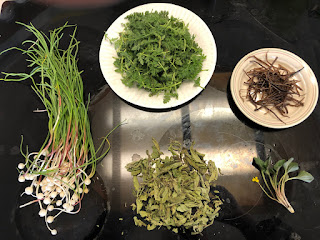 |
| Erodium cicutarium |
The common name for Erodium cicutarium is Stork's Bill or Redstem Filaree. Personally, I don't think the stems are very red, so just calling it Filaree is settling best in my mind. It might also be called Crane's Bill, but that usually refers to certain Geraniums, which have similar looking seeds. Same family; different genus. A more appropriate name might be Heron's Bill, since Erodium is greek for Heron. It sprouts and blooms extremely early in the spring, and I often notice the little rosettes of feathery leaves already with its purple flowers long before anything else has started to grow. Some accounts say that the leaves taste better before it flowers, but you would need to be looking for it in February to find it that way. Later, as it is now, it grows into some dense mats of foliage with both flowers and seeds, which is how it appears in the photo.
The seed pods are distinctive, and have the crane's bill or stork's bill shape which is a feature found in many plants in the Geranium family, In addition, the pods grow in groups of 3-6 on little reflexed stems which all meet together at one point. Those long extensions on the seeds turn into long awns which twist and untwist when they get wet or dry. My local university has a video of how this helps the seed drill its way into the soil. They also have a video on identifying this plant, so I'll link to that too.
Harvesting is mainly a matter of finding a good amount of growth which doesn't have other plants mixed in and sort of mowing it off with a knife. I am able to easily get a fairly large amount without much effort, as long as I find a place where a lot of it is growing. Remember to wash them thoroughly because they like to grow in sandy places and the hairs on the leaves and stems can hold onto some grit.
The raw taste makes me think of mild but bitter parsley. It's bitter enough that I have not often been tempted to experiment more with it. But it turns out that cooking improves the flavor quite a bit. After boiling for 10 minutes it has lost the bitterness, and has a hearty flavor which could be compared to stinging nettle. The tea made from the plant was especially good and hearty-flavored, and reminded me of stinging nettle broth, so I decided to try making soup with it, and a lot of the other wild things which are available at this time of year.
 |
| Filaree soup ingredients |
- Filaree leaves (I separated the leaves from the seeds and stems, which can still be used for teas.) top middle
- Stinging Nettle leaves (I used dried leaves; they reconstitute well in the soup.) bottom middle
- Wild Onions (Peel and cut the little bulbs in half; chop the greens. I saved half of the greens to put on the soup as it was served.) left side
- Violet leaves. (Just a few as bit of thickener.) bottom right
- Waterleaf root. (Pre-cooked; this takes a lot longer than the other ingredients to cook. See that article for instructions.) top right
- Elm samaras. (I like these still crisp, so I just put the on top of the soup before serving.)